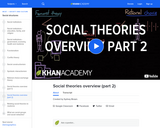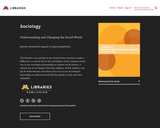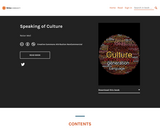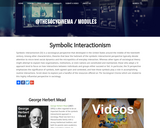
This video discusses Feminist Theory and Rational Exchange Theory.
- Subject:
- Social Science
- Sociology
- Material Type:
- Lesson
- Provider:
- Khan Academy
- Author:
- Sydney Brown
- Date Added:
- 02/28/2018

This video discusses Feminist Theory and Rational Exchange Theory.

Sociology Live! is a series of open source videos available on youtube.com for faculty and students in sociology. Using VideoScribe technology, these videos precisely explain complex sociological theories and concepts and engage both auditory and visual learners. Engaging different types of learning styles is important as students report losing attention in class can be as short as 30 seconds into the class period and up to 10-20 minutes in length. Students report shorter lapses in attention when faculty use non-lecture pedagogy. With each video being six minutes or less they can be easily incorporated into any face-to-face Introduction to Sociology course or embedded online. Discussion questions are included at the end of each video.

The founders of sociology in the United States wanted to make a difference. A central aim of the sociologists of the Chicago school was to use sociological knowledge to achieve social reform. A related aim of sociologists like Jane Addams, W.E.B. DuBois, and Ida B. Wells-Barnett and others since was to use sociological knowledge to understand and alleviate gender, racial, and class inequality.
Steve Barkan’s Sociology: Understanding and Changing the Social World makes sociology relevant for today’s students by balancing traditional coverage with a fresh approach that takes them back to sociology’s American roots in the use of sociological knowledge for social reform.
Print on demand edition available here: https://www.uncpress.org/book/9781469659282/sociology/

The purpose of Speaking of Culture is to define culture and many other concepts associated with it. My hope is that the readings in this book will help you to better understand the breadth of the concept of culture and provide you with a vocabulary for discussing it more articulately.
Culture is one of those broad concepts that is used widely, although somewhat imprecisely, in everyday English. It also cuts across many academic disciplines, and this book draws on many of them. It touches, for instance, on anthropology, biology, history, mythology, political science, psychology, and sociology.

Video lesson about stereotypes, stereotype threat, and self fulfilling prophecy.

Symbolic interactionism (SI) is a sociological perspective that developed in the United States around the middle of the twentieth century. Among other characteristics, theories that bear the hallmark of the symbolic interactionist perspective typically devote attention to micro-level social dynamics and the micropolitics of everyday interaction. Whereas other types of sociological theory might attempt to explain how organizations, institutions, or even nations are constituted and maintained, those who adopt a SI approach tend to focus on how interactions between individuals and groups either succeed or fail. In particular, the SI perspective emphasizes the significance of symbols, both agreed upon and contested, and how those symbols play a role in accomplishing routine interactions. Scroll down to explore just a handful of the resources offered on The Sociological Cinema which are related to this highly influential perspective in sociology.

Now more than ever, it's important to look boldly at the reality of race and gender bias -- and understand how the two can combine to create even more harm. Kimberlé Crenshaw uses the term "intersectionality" to describe this phenomenon; as she says, if you're standing in the path of multiple forms of exclusion, you're likely to get hit by both. In this moving talk, she calls on us to bear witness to this reality and speak up for victims of prejudice.

Protecting the United States from terrorist attacks is the FBI’s number one priority. The Bureau works closely with its partners to neutralize terrorist cells and operatives here in the United States, to help dismantle extremist networks worldwide, and to cut off financing and other forms of support provided to foreign terrorist organizations.

Infographics on the distribution of wealth in America, highlighting both the inequality and the difference between our perception of inequality and the actual numbers. The reality is often not what we think it is.

When most people think of ethics (or morals), they think of rules for distinguishing between right and wrong, such as the Golden Rule ("Do unto others as you would have them do unto you"), a code of professional conduct like the Hippocratic Oath ("First of all, do no harm"), a religious creed like the Ten Commandments ("Thou Shalt not kill..."), or a wise aphorisms like the sayings of Confucius. This is the most common way of defining "ethics": norms for conduct that distinguish between acceptable and unacceptable behavior.

Voting is among our most fundamental domestic responsibilities and important civic opportunities. Without free and open elections, American democracy would not exist. Maintaining and improving our system of elections requires not only documenting election results, but also understanding the composition of America’s electorate, both historically and presently.

The World Factbook provides basic intelligence on the history, people, government, economy, energy, geography, environment, communications, transportation, military, terrorism, and transnational issues for 266 world entities.

National estimates of the percentage of the population falling below the poverty line are based on surveys of sub-groups, with the results weighted by the number of people in each group. Definitions of poverty vary considerably among nations. For example, rich nations generally employ more generous standards of poverty than poor nations.

It's perfectly human to grapple with questions, like ‘Where do we come from?’ and ‘How do I live a life of meaning?’ These existential questions are central to the five major world religions -- and that’s not all that connects these faiths. John Bellaimey explains the intertwined histories and cultures of Hinduism, Judaism, Buddhism, Christianity and Islam.